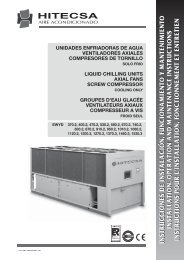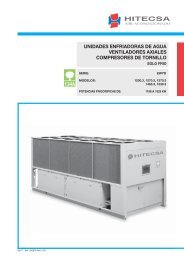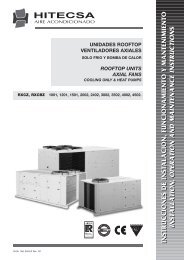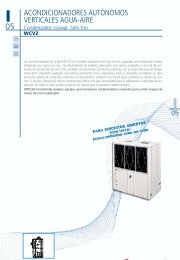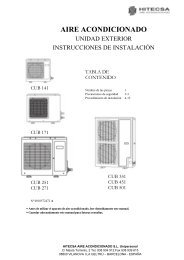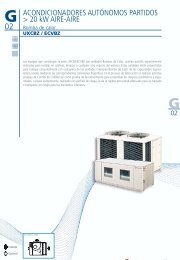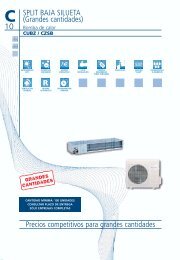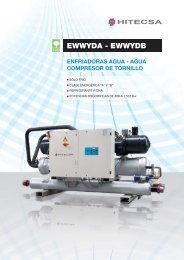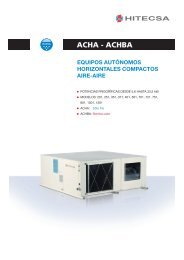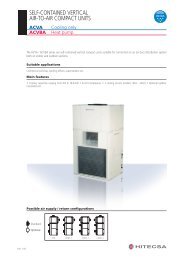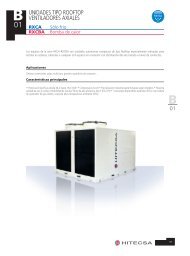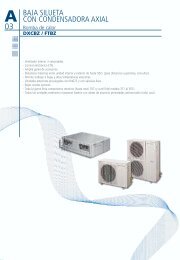instrucciones de instalación, funcionamiento y - Hitecsa
instrucciones de instalación, funcionamiento y - Hitecsa
instrucciones de instalación, funcionamiento y - Hitecsa
Create successful ePaper yourself
Turn your PDF publications into a flip-book with our unique Google optimized e-Paper software.
STARTING UP<br />
START-UP OF ELECTRIC HEATERS AND HUMIDIFIER SECTION<br />
The A/C units will operate only if the settings, with respect to ambient conditions, require it, regardless of whether the units<br />
are equipped with a microprocessor controller or a plain electrical control.<br />
Once the units have been started-up, check that the input power of the various components do not exceed <strong>de</strong>sign values.<br />
Be sure that the safety thermostats for the electric heaters have been set at about 70-80°C.<br />
The humidifiers must be supplied with normal, domestic tap water, and the tubes should be of plastic or PVC (RILSAN) with<br />
a diameter of 6mm. Pressure should be contained between 1,5 and 5 bar.<br />
The supply water to the humidifier should not be treated chemically or otherwise.<br />
N.B. When connecting tubes to the humidifier, make sure that no dirt or other material remains in the tubes. I<strong>de</strong>ally, after the<br />
unit has been started-up and ma<strong>de</strong> to operate for a little while, remove the solenoid valve of the humidifier, drain a little<br />
water, clean the base and the valve as well as the filter in or<strong>de</strong>r to ensure that no material or dirt has remained within the<br />
tubes (otherwise this could damage the valve and the valve-base and cause leakage).<br />
For further information regarding the humidifier refer to the specific manual and the indications of the humidifier<br />
manufacturer.<br />
REFRIGERANT GAS CHARGE FOR THE VARIOUS UNITS<br />
For those units that have separate con<strong>de</strong>nsers (remote con<strong>de</strong>nsers or split con<strong>de</strong>nsing units), the values indicated refer to a<br />
distance of about 10 metres between indoor unit and outdoor unit.<br />
For circuits that are greater than 10 metres, the amount of refrigerant gas should be increased according to the length and<br />
size of the piping.<br />
For each kg. of gas ad<strong>de</strong>d to fill the piping, 50/80 gr. of non-freeze oil for the compressor should ad<strong>de</strong>d. The quantity<br />
of oil <strong>de</strong>pends on how the system has been installed, whether it allows the return of the oil to the compressor more or less<br />
easily.<br />
THE TYPE OF OIL IS ALWAYS INDICATED ON THE COMPRESSOR LABEL - the type is SHELL, usually Suniso Oil<br />
3G when the refrigerant gas is R22.<br />
If R407c or R134a is used, the oil is Polyester (POE), usually EAL Artic 22CC Mobil or EMKARATE RL32S ICI (these<br />
oils used for the same gas can be mixed). Great care should be taken that the oils do not come into contact with the air<br />
and that the piping has been perfectly dried.<br />
Keep in mind that in systems that have lengthy and extensive pipe work and/or are equipped with larger con<strong>de</strong>nsers than<br />
normal, it is advisable to fit in the circuit an extra liquid receiver in or<strong>de</strong>r to better handle the larger quantity of refrigerant gas<br />
that has been loa<strong>de</strong>d. This should allow the possibility of gathering all the gas in the receivers in case of maintenance or<br />
specific repair work to the system.<br />
44 05.08 Ref.200989 Rev.100



